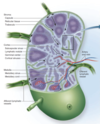Blood and Lyphatic System Flashcards
(40 cards)
What are the functions of blood? (3)
Transport of various materials (O2, CO2, nutrients, waste, hormones, etc)
pH buffer (~7.35 - 7.45)
Thermoregulation
Plasma refers to ____
all fluid components of blood
Serum refers to _____
plasma minus clotting factors
Interstitial fluid refers to ____
fluid surrounding cells, derived from blood plasma
Anemia refers to _____
decrease in hemoglobin concentrations; broad term
What is the function of albumin in the blood?
Maintains blood pressure and volume
most abundant circulating protein
What are the components of blood plasma? (3)
92% water
7% Proteins (albumins, clobulins, fibrinogen, etc)
1% other solutes (electrolytes, nutrients, etc)
Why are erythrocytes known as a “histologic ruler?”
They are uniform in size and shape, so they are used to estimate size of surrounding tissue

What is the significance of erythrocytes being biconcave? (2)
Increases surface area for O2 transport
Increases flexibility to fit through small capillaries
Identify each blood type (A, B, AB, & O):


What is the difference between internal and external respiration?
Internal respiration is gas exchange between the tissues and erythrocytes
External respiration is gas exchange between erythrocytes and the lungs
What are thrombocytes? What are their functions?
Acellular fragments (platelets)
Control bleeding
initiate repair of injured blood vessels

Describe the “four” steps of blood clotting
- Thrombocytes adhere and attract other thrombocytes at site of injury
- Form fibrin mesh to stop erythrocytes from escaping
- Initiate wound healing (MANY STEPS)
- Break apart when healed
What type of leukocyte is this? What are its subtypes and what are their functions?

Lymphocyte (B & T cells)
B cells (plasma cells outside blood) make antibodies
T cells activate B cells and macrophages, but can also kill directly
What is the difference between CD4 and CD8 T-cells?
CD4 activate B-cells and macrophages
CD8 kill virus-infected cells directly
What type of leukocyte is this? What are its functions?

Monocyte
Chemotaxis (“going to the battlefield”)
Phagocytosis
Becomes a macrophage outside of the blood
What type of leukocyte is this? What are its functions?

Neutrophil
Phagocytize bacteria
“First responders” to site of infection, injury, etc.
Short-lived
What type of leukocyte is this? What are its functions?

Eosinophil
Kill parasitic worms
Anti-bacterial
contains enzymes that break down histamine (important in allergies and asthma)
What type of leukocyte is this? What is its function?

Basophil
Rare
Release histamine and other mediators of inflammation
What are the two types of bone marrow? Which one is active and which one is inactive?
Red: active
Yellow (adipocytes): inactive
What are the primary locations of bone marrow in children and adults?
Children: all bones
Adults: heads of humerus & femur, hips, skull, ribs, and vertebrae
What is the function of bone marrow?
Site of development for erythrocytes, leukocytes, and thrombocytes
What type of cell is depicted here (red)? What is its function?

Megakaryocyte
creation of thrombocytes

Define hemopoiesis
broad term for the formation of various types of blood types



















